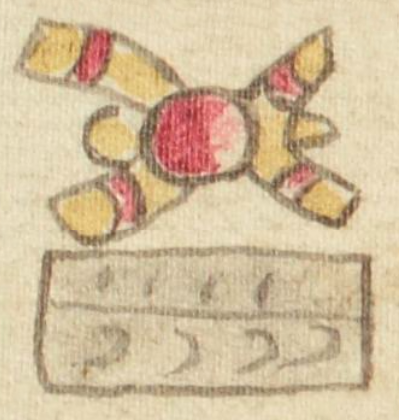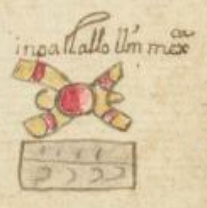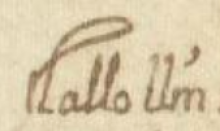tlalolin (Azca15)
This colorful painting is a compound glyph for the noun tlalolin (“Earthquake”). It shows a bird-s eye view of a rectangular piece of agricultural land (tlalli), divided in half horizontally, with four short lines in the top half and four backward C-shapes in the lower half. This piece of land is gray. The markings may suggest agricultural activity. Above this rectangle is a sign for movement (olin). It is an X-shape that is painted yellow, but each of the four legs of the X have a dark red stripe across them. At the intersection of the X is a circle, painted half dark red, and half pink. Intersecting the X, peeking out from behind is what might be described as an axis, rounded on the left and pointed on the right.
Stephanie Wood
As examples of olin glyphs show, below, the axis behind the legs or wings of the X-shape can be vertical or horizontal. The circle in the center, here, is somewhat more like the starry eye than the rubber ball found in some other tlalolin glyphs. The piece of land is somewhat less detailed than usual. Compare below.
Stephanie Wood
tlallollin
tlalolin
Stephanie Wood
post-1550, possibly from the early seventeenth century.
Jeff Haskett-Wood
terremotos, temblores, tierra, movimiento, sismo

tlalolin, earthquake, https://nahuatl.wired-humanities.org/content/tlalolin
Temblor
Stephanie Wood
The Codex Azcatitlan is also known as the Histoire mexicaine, [Manuscrit] Mexicain 59–64. It is housed in the Bibliothèque Nationale de France, and hosted on line by the World Digital Library and the Library of Congress, which is “unaware of any copyright or other restrictions in the World Digital Library Collection.”
https://www.loc.gov/resource/gdcwdl.wdl_15280/?sp=15&st=image
The Library of Congress is “unaware of any copyright or other restrictions in the World Digital Library Collection.” But please cite Bibliothèque Nationale de France and this Visual Lexicon of Aztec Hieroglyphs.






